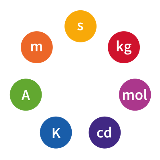Base units

Base units
| unit | symbol | quantity | definition |
|---|---|---|---|
| second | s | time | ground-state hyperfine transition frequency νhf of 133Cs = 9,192,631,770 Hz *) |
| meter | m | length | speed of light c in vacuum = 299,792,458 m·s-1 |
| kilogram | kg | mass | Planck's constant h = 6.626,070,15×10-34 J·s **) |
| ampere | A | current | electron charge e = 1.602,176,634×10-19 A·s |
| kelvin | K | temperature | Boltzmann's constant kB = 1.380,649×10-23 J·K-1 **) |
| mole | mol | matter | Avogadro's constant NA = 6.022,140,76×1023 mole-1 |
| candela | cd | luminous intensity | 1 candela = luminous intensity of standard source ***) |
*) 1 Hz = 1 s-1
**) 1 J = 1 kg·m2·s-2
***) radiation source with frequency = 540×1012 Hz and emitting energy = 1/683 J per second and per steradian